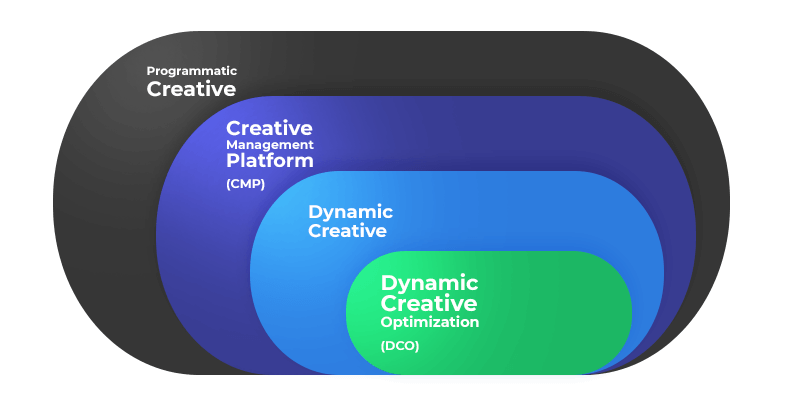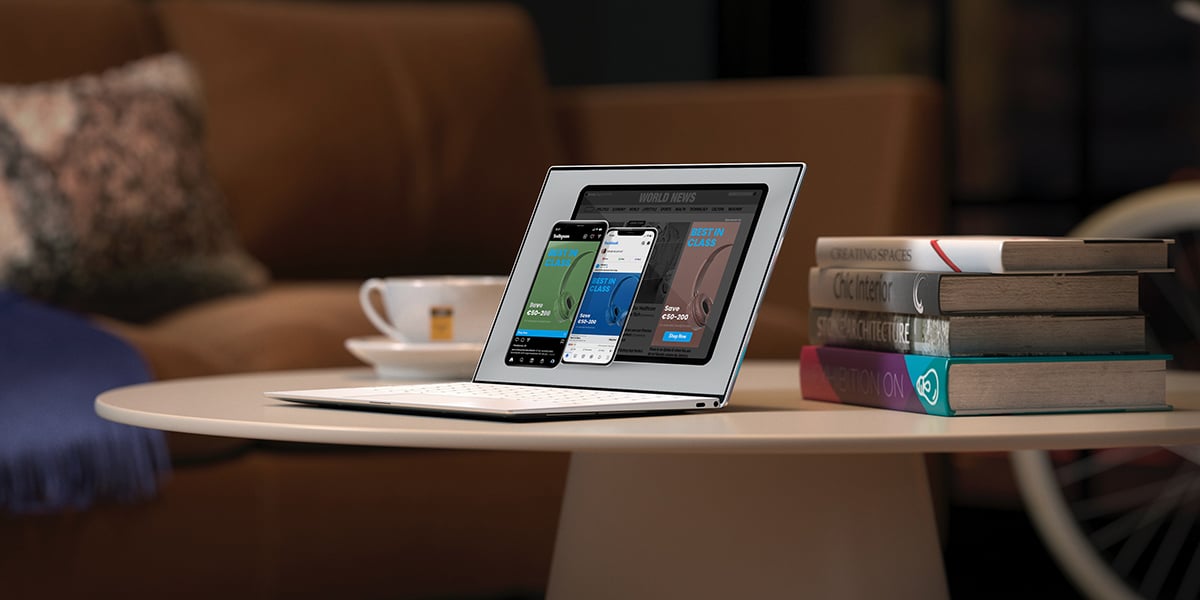Programmatic creative is so much more than presenting the right offer at the right time. It provides unbeatable display advertising performance through the automation and control of all aspects of a display campaign.
Performed correctly, programmatic creative enables marketers to easily produce sophisticated and targeted display advertising.
In this blog, we will define what programmatic creative is, what it includes, and suggest different programmatic creative technologies. We will do this by answering the following questions:
- What is programmatic creative?
- Why use programmatic creative?
- Why is the “creative” part of programmatic creative so important?
- What are the essential programmatic creative technologies?
- Creative management platforms (CMP)
- Dynamic creative
- Dynamic creative optimisation (DCO)
1. What is programmatic creative?
Programmatic creative is the automation of the building, publishing and optimising processes of display advertising. It is an umbrella term for a range of different dynamic strategies and technologies, all of which aim to add speed, scale, relevance and performance to display campaigns.
Programmatic creative is also a result of the adoption and growth of a range of programmatic advertising technologies. Programmatic advertising being the automated transaction of buying and selling of advertising online.
If you wish to know more about programmatic advertising please read this ultimate guide.
2. Why use programmatic creative?
Today, programmatic advertising is how the majority of display advertising is served. It is highly unlikely that a marketer will not buy inventory programmatically. It is, therefore, the default method of publishing display advertising.
Indeed, in 2019, US total spend on programmatic advertising is set to reach $59.45 billion, and account for 84.9% of all display advertising. By 2021, the prediction is that it will account for 88% of all US display advertising, and spend will reach over $81billion!
Using programmatic creative technologies, such as creative management platforms (CMPs) enables marketers to make the most of this growth. Marketers can benefit by combining ad automation, data and creativity to increase their display advertising performance.
3. Why is the “creative” part of programmatic creative so important?
If done right, programmatic creative is an effective way for marketers to stand out in an ever more crowded field. This is especially important as more and more advertisers are using programmatic display, and the cost of entry is getting lower and lower. But why is the “creative” part of programmatic creative so important?
Firstly, “creativity” within programmatic creative doesn’t just mean design! It is the way in which marketers use programmatic buying to target (and retarget) consumers. As any media buyer will tell you, you can use data creatively to reach the right customer at the right time, with the right message.
Secondly, marketers need to remember that behind every ad is a real customer. To stand-out and be impactful having the right message, at the right time, is no longer enough. You must also reach your target with the best “creative” combination. As Zoe Harris, CMO of GoCompare writes in Marketing Week, “a poor story can’t be helped in any channel, no matter the spend that’s put behind it”.
4. What are the essential programmatic creative technologies?
Programmatic creative technologies paired with programmatic buying enable marketers to reach the right customer, at the right time – and present the most relevant message. The analysis of data from these processes enables even greater relevancy through personalised messaging. This allow marketing teams to improve performance through ad customisation.
Indeed, programmatic customisation is now common practice for many marketing teams. Nikki Gilliland of Econsultancy notes that “vast amounts of data mean[s] that advertising creative can dynamically change to be more relevant to customers, with ads adapting to factors like location, device, weather, time, and demographics”. Yet, what is the best way to achieve this?
These are the three key programmatic creative technologies that display advertisers need to use:
Creative management platforms (CMPs)
Creative management platforms enable marketing teams to rapidly build and publish quality display advertising across formats. As well as use data to customise images and messages based on real-time ad analytics.
Using a CMP, even the smallest of in-house teams can become an ad factory. Smart automation means teams can produce countless display ad variations for multi-market, multi-audience campaigns.
For example, hotel chain, Meliá Hotels International using the Bannerflow CMP, produces over 2000 ad variations for different audience segments every week. Without a CMP this creation aspect of programmatic creative is impossible.
Furthermore, without the use of a CMP other programmatic creative technologies such as dynamic creative and dynamic creative optimisation (DCO) are too complex or impossible. This is because both require complex individual HTML5 coding and repetitive design processes – all of which a CMP performs automatically.
Programmatic creative best practices
As we have seen, programmatic advertising is fast becoming the dominant force in display advertising. In fact, many brands are already ahead of the curve when it comes to successfully deploying programmatic-based campaigns.
But what makes a successful programmatic creative? We’ve shared some best practices below:
Ensure a good first impression: the initial focus should be to capture user attention, with engaging visuals and a clear call to action. Avoid the hard-sell and instead opt for lifestyle-led imagery that explains why a user should shop with your brand. Try featuring compelling call to actions such as ‘learn more’ or ‘explore now’.
Stay top-of-mind: remind the user why they chose to visit your website in the first place. Here, brand recognition is key. Ensure your logo is visible and make it easy for the user to pick up where they left off and visit the site. Highlight new items, show different products, and use a stronger call to action encouraging users to ‘buy now’ or ‘shop now’.
Personalise the ads: now that you’ve hooked interested shoppers, the goal is to personalise your advert to persuade the user to convert. To do that, test and feature a range of items. This could include most popular items, sale products or goods that they have already browsed.
Reward customer loyalty: users love to be rewarded for their ongoing loyalty. Recognising their positive relationship can go a long way to secure long-term value. Translate this loyalty within ads by personalising call to actions or providing them with additional promotions. Adopt a more personalised call to action and tone within your advert, such as “you might like these” or “complete the set”.
So, what does the above look like in practice? We’ve compiled some of our favourite adverts below:
- Meliá’s in-house team produced thousands of personalised brand consistent display ads from one platform.
- Shutterstock were able to create global campaigns in the cloud and build eye-catching display campaigns
- Casumo were able to take their personalisation to the next level through Dynamic Creative Optimisation (DCO) and serve different messages, images and CTAs all within one campaign
Programmatic creative vs. Dynamic creative
When comparing programmatic creative and dynamic creative, it is important to recognise that they are the same technology. Dynamic creative is simply a subset of programmatic creative.
We know that programmatic creative is automation of the building, publishing and optimising processes of display advertising.
Dynamic creative is a method of programmatic, which lets an advert be modified in real-time based on predefined parameters and rules set by the advertiser.
A successful dynamic creative relies on deploying the correct programmatic technology, which we will now explore.
Dynamic creative
Dynamic creative is advancing in adoption and sophistication. This is thanks to the ad tech infrastructure built up to support programmatic media buying.
Better use of audience data, segmentation and targeting strategies, as well as optimised bidding strategies based on analytics has seen this aspect of programmatic creative grow.
Dynamic creative is a programmatic creative strategy that can use a viewer’s location, what they’re reading, the weather, what device they’re on – among many other data options – to select the best pre-built display ad variation to present to a customer.
It also refers to the use of data feeds within a display ad that are tailored to present the most up-to-date or relevant information for a particular viewer. For example, a sports betting company based in the UK, using dynamic creative, is able to retarget a German customer, with the latest odds and ad creative for a Bundesliga match – across both mobile and desktop.
However, in order for dynamic creative to be successful, having the right programmatic creative technology is a must. Therefore, to create the ad variations required, simply and quickly, a combination of a CMP, demand side-platform (DSP) and data management platform (DMP) is recommended.
Dynamic creative optimisation (DCO)
Dynamic creative optimisation is next level dynamic creative. It is currently the best combination of programmatic creative technologies available to marketers who do display advertising.
DCO allows marketers to optimise and customise the best creative combination for a particular audience segment. By using a CMP these ad variations are easily designed and optimised in real-time through continuous A/B testing – enhancing ad performance and relevancy.
However, within DCO there are different types of DCO! For example, template-based DCO, is manually coded and pre-programmed. This means while ads can be rendered in real-time, only elements such as text and images adapt to user data. This can work very well but often leads to boring ads with product feeds with some personalised text and not much more.
The ultimate form of programmatic creative is DCO that uses a CMP. A CMP, in combination with a DCO platform, enables more creative ad concept and the use of a selection of different ad variations. For example, in-banner video and other interactive features. DCO with a CMP means greater creative control and impact through creative ad design.
Conclusion
Programmatic creative covers a range of technologies and offers different levels of sophistication. At its heart, is the aim to increase display advertising performance through automation. However, this greater use of automation also enables more creativity, which if done well, allows marketers to produce more relevant and engaging advertising.
One way of achieving outstanding display advertising through programmatic creative is by using a CMP. If you would like to find out more about how CMPs can help push your display campaigns to the next level then please get in touch, or apply for a demo of Bannerflow.









